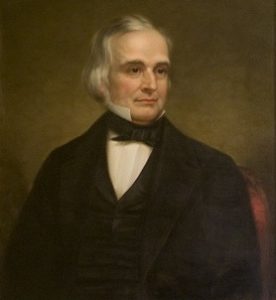Situated along the Shetucket River in Sprague, Connecticut, lies the remains of what was once the nation’s largest textile mill. At its peak, over 1,000 employees operated 1,750 looms and 70,000 spindles to produce some of the country’s finest cotton. The Baltic Mill (as it became known) not only helped reshape Connecticut’s economic and cultural landscape, but its geographic one as well, giving rise to the founding of an entirely new town.
Development in the area around modern-day Sprague took hold in 1854, when the Hartford, Providence, and Fishkill Railroad reached the towns of Lisbon and Franklin (on either side of the Shetucket) at a place called Lord’s Bridge. Shortly afterward, the former governor and US senator from Rhode Island, William Sprague III, took an interest in the area around Lord’s Bridge due to its abundant supplies of water power, inexpensive land, access to the new railroad, and numerous unemployed railroad workers. Sprague purchased 300 acres there and erected a textile mill.
Incorporating the Town of Sprague

William Sprague, 1799-1856 – Public Domain Image
The waters of the Shetucket River effectively powered Sprague’s machinery and the company’s facilities soon expanded on both sides of the river—in an area that some referred to as the village of Baltic. Supervisors lived in ten buildings to the northeast of the mill. Across the river, mill workers filled nearly 100 houses, arranged in a gridiron pattern. A footbridge over the Shetucket connected the village and mill. But the complications of running a business out of two towns, along with tensions that arose between longtime Baltic residents and new mill workers, encouraged mill management to petition the state for the incorporation of a new town. The state acquiesced in 1861 and incorporated the area as the town of Sprague.
The thriving A. & W. Sprague mill doubled its employment in the 1860s, bringing new populations of largely Irish and French-Canadians to the area. By 1870, 804 men, 396 women, and 210 children worked in the Baltic Mill. The emergence of small local businesses followed close behind as did the commerce enjoyed by a company-run store that sold food and household goods to the mill workers.
But the debt the Spragues incurred during their massive expansion soon caught up with them. As credit tightened across the country, the Depression of 1873 set in, decimating the company’s finances. The Spragues were forced to scale back their operations. Then, in 1877, a fire destroyed the interior of the mill, bringing an end to the Spragues’ business.
Renewed Efforts at the Baltic Mill

Former Baltic Mill Warehouse, Baltic
Several decades later, around the turn of the century, a businessman from Pawtucket, Rhode Island, named Frederick Sayles purchased the property with an eye toward revitalizing the local textile industry. He founded the Baltic Mills Company and set about making extensive repairs and upgrades to the property. Unfortunately for Sayles, the New England textile industry had begun to decline and it wasn’t long before the company’s depleted finances forced Sayles to sell off much of its assets. The company did survive long enough to produce uniforms, parachutes, and life rafts for soldiers in World War II, but the mill’s operations ultimately came to a halt in the latter part of the 1960s.
While its cotton-producing days were over, the mill facility did go on to serve as a mail-order house in the 1970s, and then briefly as a home to a fiberglass boat manufacturer, before a non-profit group purchased the property in 1994 to save it from destruction. Both the mill site and the surrounding village went on to earn listings on the National Register of Historic Places.








